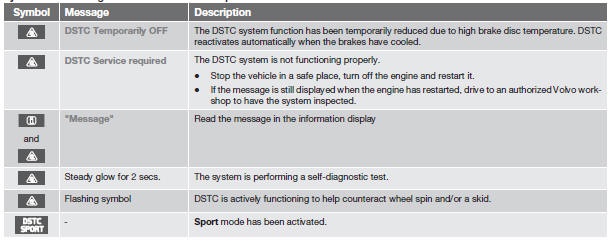Operation

Sport mode
The stability system is always activated and cannot be switched off.
However, the driver can select Sport mode, which offers more active driving characteristics. In this mode, the engine management system monitors movement of the accelerator pedal and steering wheel for sportier driving by allowing more lateral movement of the rear wheels before DSTC is activated.
Under certain circumstances, such as when driving with snow chains, or driving in deep snow or loose sand, it may be advisable to temporarily use Sport mode for maximum tractive force.
If the driver releases pressure on the accelerator pedal, DSTC will also activate to help stabilize the vehicle.
To switch to Sport mode:
1. Press the My Car button in the center console control panel and select My S60 DSTC in the menu.
2. Unselect the symbol and leave the menu by pressing EXIT.
> This puts DSTC in Sport mode.
Sport mode remains active until the driver switches it off in the menu or until the engine is switched off. DSTC will return to normal mode when the engine is restarted.
Symbols and messages in the main instrument panel

![]() WARNING
WARNING
The stability system is intended to help improve driving safety. It supplements, but can never replace, the driver's judgment and responsibility when operating the vehicle. Speed and driving style should always be adapted to traffic and road conditions.
See also:
Decals
There are various types of decals in the vehicle whose purpose is to provide
important information in a clear and concise way. The importance of these decals
is explained as follows, in descending ...
Interior
The standard upholstery in the five-occupant interior has a slightly coarse
woven feel said to be inspired by sportswear. Leather upholstery is available.
Volvo says storage space is improved both ...
Safety & Reliability
The C70 scores the highest rating, Good, in the Insurance Institute for
Highway Safety's frontal offset and side-impact crash tests, as well as for
rear-crash protection.
In addition to the requ ...
